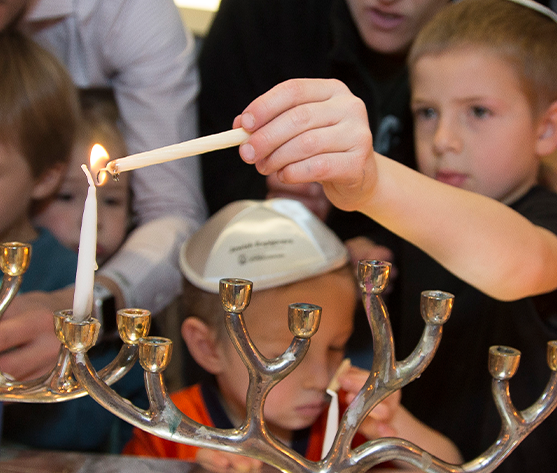An Ingrained Act of Inclusion
By Rabbi Amanda Schwartz
Last week we concluded the holiday of Hanukkah, in which we add more and more light each of the eight nights. Ingrained in the holiday is an act of inclusion, adding a “shamash” a helper candle to the Hanukkah candles. If you think back to days pre-electricity, lighting oil lamps or candles was the norm, it’s basically the equivalent of us turning on the light switch. The Hanukkah candles were deemed distinct from every day and even Shabbat candles because a tradition was created that these candles should not be “used” for practical purposes but, rather, should simply be used for enjoyment as a way of publicizing the miracle of Hanukkah.
The sages of long ago recognized that asking people to buy and light candles simply for enjoyment was an expensive request and they did not want to limit people with limited funds from participating in the holiday. Thus, the tradition of the “shamash” emerged, where everyone would light an additional candle, known as the shamash and then it was considered appropriate to use the light of the shamash for practical purposes and the other Hanukkah candles were simply for enjoyment. Now, obviously, this is a bit of a work around because, of course, the other candles also generated light. But it was an important addition to the ritual so that everyone could participate equally and fully.
This example is only one of countless examples in Jewish wisdom and tradition of how inclusion is central to the religion. Not only is inclusion central to Judaism but it’s also central to Judaism Your Way, which was founded upon the Torah of Inclusion. Because of our drive to be a fully open tent, we recently sent out a survey asking about the lives of people connected to Judaism Your Way and how inclusive our community is perceived. We received responses from over 600 community members. Of those respondents 30% shared that we face barriers to participate fully in Jewish life because of the following challenges: auditory or hearing, chronic health conditions, social/emotional/mental health, challenges due to aging, mobility, allergy, sensory, cognitive/learning or visual. Additionally, we learned that one of the ways we are perceived as being least inclusive, is for people with disabilities.
February is recognized worldwide as Jewish Disability Awareness and Inclusion month (JDAIM) as a way of raising awareness and fostering inclusion of people with disabilities. Judaism Your Way is not alone in needing to create more inclusion in the Jewish community, rather, a recent study found that while disability inclusion has improved over the last five years, there is still a lot of work to be done, which is why JDAIM is so important.
A group of Judaism Your Way volunteers and staff members have begun planning our JDAIM Shabbat aLIVE program, which will be held on February 18. We made the decision that this event will be held as an exclusively virtual event in order to be as accessible as possible. One of the findings of the study about inclusion discovered that “the surge in the use of virtual formats in response to the COVID-19 pandemic increased the ability of 73 percent of disabled individuals to access their faith community.”
Across Colorado, communities will be focusing during JDAIM on the theme of chronic pain and chronic illness. From our survey, we know that nearly 10% of the JYW respondents experience chronic illness. That is a LOT of people in our community!
To raise awareness about chronic pain and illness, we would like to lift up the voices of JYW community members who experience chronic pain and illness and invite you to speak at Shabbat aLIVE about how these conditions impact your life. If you are interested in sharing some of your story about chronic pain and illness, please contact me at amanda@judaismyourway.org.
We don’t know for sure how long the shamash has been used for Hanukkah, though a reference to it first appears in a Jewish code of law from the 16th century. Since then, the practice of adding a shamash has become so natural that we no longer even think about how it was originally done for the sake of inclusion. In fact, I think we can probably agree that it would now feel unusual to light Hanukkah candles without a shammash. To be sure, we have work to do to create a fully inclusive Jewish community. And yet, I have hope, that hundreds of years from now, we will have so many new inclusive practices engrained into Jewish life that they will feel as if they have always been a part of Jewish life, making it richer and brighter, just like the shammash.
Rabbi Amanda Schwartz
Judaism Your Way Family Life Director


